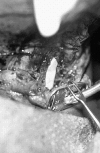Obstructive lesions of the pediatric subglottis
Abstract
Purpose: To compile information regarding obstructive subglottic lesions in children, including anatomy, pathogenesis, prevention, evaluation, and treatment options, required for implementation of a multi-faceted treatment plan.
Method: Review of the literature.
Conclusions: Although they are infrequent, obstructive subglottic lesions pose significant challenges to treating physicians, from airway management and injury prevention to decannulation and voice rehabilitation. Most patients with these lesions require multidisciplinary care and long-term treatment and can nearly always be treated successfully.
Keywords: Airway reconstruction; laryngotracheoplasty; pediatric airway; stridor; subglottic hemangioma; subglottic stenosis; subglottis.
Figures










Similar articles
-
Minimally invasive endoscopic management of subglottic stenosis in children: success and failure.Int J Pediatr Otorhinolaryngol. 2011 May;75(5):652-6. doi: 10.1016/j.ijporl.2011.02.002. Epub 2011 Mar 5. Int J Pediatr Otorhinolaryngol. 2011. PMID: 21377219
-
Ectopic Thymic Cyst of the Subglottis: Considerations for Diagnosis and Management.Ann Otol Rhinol Laryngol. 2018 Mar;127(3):200-204. doi: 10.1177/0003489417749609. Epub 2017 Dec 31. Ann Otol Rhinol Laryngol. 2018. PMID: 29291277
-
Subglottic Hemangioma: A Hidden Mass Presenting in an Unusual Age Group.Cureus. 2023 Apr 29;15(4):e38293. doi: 10.7759/cureus.38293. eCollection 2023 Apr. Cureus. 2023. PMID: 37255907 Free PMC article.
-
Efficacy and rebound rates in propranolol-treated subglottic hemangioma: A literature review.Laryngoscope. 2017 Nov;127(11):2665-2672. doi: 10.1002/lary.26818. Epub 2017 Aug 23. Laryngoscope. 2017. PMID: 28833230 Review.
-
Subglottic hemangioma.Otolaryngol Clin North Am. 2008 Oct;41(5):903-11, viii-ix. doi: 10.1016/j.otc.2008.04.009. Otolaryngol Clin North Am. 2008. PMID: 18775341 Review.
Cited by
-
Case report: Idiopathic subglottic stenosis in a girl; successful treatment with macrolides.Front Pediatr. 2022 Aug 18;10:888282. doi: 10.3389/fped.2022.888282. eCollection 2022. Front Pediatr. 2022. PMID: 36061399 Free PMC article.
-
Difficult intubation in a neonate: a diagnostic dilemma.BMJ Case Rep. 2018 Nov 28;11(1):e224769. doi: 10.1136/bcr-2018-224769. BMJ Case Rep. 2018. PMID: 30567083 Free PMC article.
References
-
- Hast M. H. The developmental anatomy of the larynx. Otolaryngol Clin North Am. 1970;3:413–438. - PubMed
-
- O'Rahilly R., Tucker J. A. Early development of the larynx in staged human embryos. Ann Otol Rhinol Laryngol. 1973;82:1–27. - PubMed
-
- Tucker J. A., Tucker G. F. Some aspects of fetal laryngeal development. Ann Otol Rhinol Laryngol. 1975;84:49–55. - PubMed
-
- Lisser H. Studies on the development of the human larynx. Am J Anat. 1911;12:27–66.
-
- Westhorpe R. N. The position of the larynx in children and its relationship to the ease of intubation. Anaesth Intensive Care. 1987;4:384–388. - PubMed
LinkOut - more resources
Full Text Sources
